Startup Looking to Eliminate Turbulence for GA Pilots Goes Viral
Austria’s Turbulence Solutions aims to measure, predict, and eliminate choppiness with its patented Turbulence Canceling technology.

A video preview of Turbulence Solutions’ turbulence-canceling technology has gained millions of views on X. [Courtesy: Turbulence Solutions/X]
Turbulence can be created in a variety of ways, from flying in the wake of another aircraft to changing speed or direction near fast-moving bands of air, even in clear conditions.
Unsurprisingly, choppiness also occurs due to updrafts or downdrafts created by storms. In recent years, however, there’s growing evidence that climate change is causing more inclement weather—and by extension, more turbulence.
But what if we could get rid of that bumpiness for good? In a viral video that has racked up more than 3.2 million views on X (formerly Twitter), Austria-based Turbulence Solutions gave a sneak peek of its Turbulence Canceling solution, which got its first customer earlier this year. The Vienna startup plans to use a combination of sensors, lidar, and flight control software to reduce the effects of turbulence by measuring, predicting, and mitigating choppiness.
Andras Galffy, founder, CEO, and head of technology and research at Turbulence Solutions, told FLYING the company first plans to integrate its solution on GA aircraft, as well as electric vertical takeoff and landing (eVTOL) aircraft for planned advanced air mobility (AAM) services.
“Even without climate change increasing turbulence, especially for light and small aircraft flying low and fast, comfort is a showstopper.” Galffy said. “A very limited number of passengers enjoy flying GA aircraft for comfort reasons. AAM and eVTOL will need to provide turbulence-free ride quality and passenger comfort for returning and recommending customers.”
Galffy, who earned his doctorate in flight control from Vienna University of Technology’s Automation and Control Institute, founded Turbulence Solutions in 2018. But the company appears to have emerged from stealth in 2022, when it began circulating the now-viral video on LinkedIn and posting on Facebook and X.
According to its website, Turbulence Solutions has already obtained a U.S. patent for its solution, with a few others in the application process. It also tested the system on board a crewed demonstrator aircraft, which it used to gather in-flight data, in 2021, Galffy said.
Based on that data, the company predicts Turbulence Canceling will reduce the load felt by passengers by more than 80 percent, though the system is a comfort feature and won’t be required for operation. The company said it will use a feedback and “feedforward” approach, combining dynamic lift control with predictive sensor technology.
The solution’s Turbulence Load Prediction component will provide the “feedforward,” anticipating choppiness in front of the aircraft. Pressure sensors and wind lidar technology will combine to measure differential pressure ahead of the wing, predicting vertical acceleration to an estimated 1 m/s/s degree of error, the company claims.
That system will send feedback to a Direct Lift Control system, which dynamically adjusts wing shape within fractions of a second (as a bird does) to reduce inertia on the flaps and stabilize angle of attack. This component will incorporate flight dynamics beyond wing root moments, including vertical acceleration, pitch, roll, and wing bending. It can be integrated on aircraft with conventional flaps or enable wing morphing.
Galffy contrasted this strategy with conventional turbulence avoidance methods, which often involve pitching the entire aircraft via elevator input. This, he said, is simply too slow of a reaction to avoid choppiness.
How Pilots Handle Turbulence
By and large, pilots know what to do when they encounter turbulence, but existing mitigation strategies aren’t exactly ideal.
Chapter 12 of the Pilot's Handbook of Aeronautical Knowledge introduces the concept of turbulence and educates about its causes and effects. Typically, the initial course of action is to slow to maneuvering speed—fast enough to keep the aircraft in level flight, but slow enough to escape structural damage from choppiness.
Pilots are required to know this speed, which is specified by aircraft gross weight in the Pilot’s Operating Handbook and is commonly placarded in the cockpit: the heavier the aircraft, the higher the maneuvering speed.
The strategy is similar to driving slowly on a bumpy road to avoid dents from potholes. For passengers, however, this can cause discomfort or raise concerns about the aircraft’s safety.
Less frequently, pilots will take a different road entirely; that is to say, they will adjust course or altitude to avoid the turbulence altogether. But for large aircraft in particular, rerouting can strain fuel requirements and increase carbon dioxide emissions. And for smaller aircraft traveling short distances at low altitude, it’s a near-impossible task, Galffy said.
In short, there is no simple recourse for pilots who encounter choppiness. On its website, Turbulence Solutions points out that eVTOL designs are also susceptible to turbulence. These aircraft are relatively light but cruise at high speeds, and turbulence could tank customer satisfaction or limit the availability of planned AAM services.
Galffy told FLYING the company has already developed systems to sufficiently reduce turbulence for light and eVTOL aircraft. This year, the startup picked up its first customer: a manufacturer of 1,300-pound ultralights.
Next up will be adding fail-operational capabilities to integrate Turbulence Canceling on larger models. Galffy mentioned business jets and airliners as potential customers. For now, though, the focus is on a simpler system for GA and eVTOL aircraft, which the CEO said is easier to certify.
Like this story? We think you'll also like the Future of FLYING newsletter sent every Thursday afternoon. Sign up now.

Subscribe to Our Newsletter
Get the latest FLYING stories delivered directly to your inbox






